 |
| The new compost pile is covered with a tarp to keep moisture in. Eventually it will fill this whole space. In the background you can see our leftover adobe bricks. |
So–our regular readers will know that we have high levels of lead in our back yard soil. We’re dealing with this by filling most of our yard with mulch and perennial natives to lock down the soil (lead laden dust is bad) and to diversify the local ecosystem.
Meanwhile, our vegetables must be grown in raised beds from now out. We used to have two main vegetable beds in the center of our back yard–they were our workhorses. Since the lead scare we’ve pulled up those beds. They were semi-sunken beds, the soil in them a mix of native soil, compost and imported soil.
When you have contaminated soil yet want to grow food, the easiest solution is to build extra deep raised beds and fill them with imported soil (soil which has, hopefully, been tested for lead!). Some people put plastic sheeting or rock barriers between the imported soil or native soil, which in effect makes the beds into giant containers.
We did something a little different–and a lot harder. We dug out a huge pit where our beds used to be. When I say “we,” I mean Erik dug a huge pit. (Somehow I weaseled out of this project.) This excavation had two purposes: 1) to remove the topsoil, where most of the lead (lead being an airborne pollutant) is located and 2) to harvest the clay beneath to use in our earth oven. Between the clay harvested for making the adobe bricks and cob, and the supplemental clay that we’ve put aside for future repairs and maintenance on the oven, the pit has grown to be about 12 feet wide and 2 feet deep.
This pit is going to be our new planting area, but obviously it needs to be filled in. Instead of buying imported soil, we’re going to grow soil by composting on a grand scale. We’re going to compost right in the pit and fill it up bit by bit. When it’s done, we’ll have a big round area where it will probably be safe enough to plant food crops. Might the plants suck some lead up from the deep clay layer? Maybe. We could test the deep clay. Might some lead leach in from the sides of the pit? Possibly. But this solution is good enough for us.
What drives us to this decision is our intuitive relationship with our yard. I know that sounds a little woo-woo, but I encourage you all to pay attention to what your gut tells you about your gardens. It won’t steer you wrong.
Our gut instincts told us to dig down rather than build up, and to make good use of excavated dirt in the oven. Now our instincts tell us to fill this giant hole with rich homemade compost rather than imported soil. It just seems more…holistic to grow out own soil. It will rise out of our meals, our labor, our intentions. It will belong to this place.
How long will this take? Probably about a year. Maybe more. We’re willing to wait for those future harvests because this feels right.
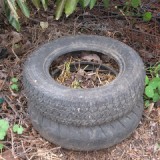
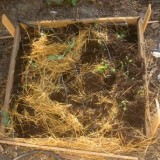
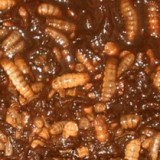
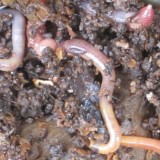
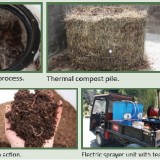
Fill um full of lead.
Well now we know where the dead bodies are buried.
You can’t fool us! LOL
Ah Russell…what are we going to do now that you’re on to us?
*Kelly puts on an innocent look* “Would you like to come see our compost pile?”
No, but if the price is right I maybe a could reserve a burial plot. It looks scenic.
Will you have to add anything to it besides pure compost?
I believe so. We’ll be researching that over the course of the year. Some plants grow in pure compost, but other plants find it too rich. I can’t speculate on the recipe right now, but it’s likely we’ll start by mixing back in some of the deep-dug clay we’ve set aside.
I’ve heard of people growing squash and potatoes directly in their compost piles. Maybe these crops will work for you the first year. Plus, they’re tasty and very versatile.
I once read of an oft-used method of ridding land of tree stumps in early America: pile manure on top and plant squash and pumpkins right into the (aged?) poop. Over time, the action of the manure and the plant roots would break up the stump. I would have tried this on our own wooded property, but the husband prefers to do everything by the most time-consuming, difficult method available: digging them out by hand, piece by piece. Anyway, I’d love to know if it actually works. The manure, I mean.
Re: stumps and manure. That’s interesting. It seems like it could work. All that damp heat? And manure often sprouts mushrooms and mushrooms eat wood.
Hmm…maybe the manure went on “hot”- to address the stump–and then they planted the squash in it once it had aged some??
Your guess is as good as mine. It was a history book written, presumably, by an historian who was not necessarily a gardener. A little skimpy on actual details, but interesting nonetheless.
Decaying wood covered in a growing medium and planted up is usually called hugelkulture these days, and it could be a really good solution in a situation where you want to build up rather than dig down. Plus it’s excellent in low water situations. You guys should definitely do some research on hugelkulture if you haven’t before. Here’s a good link to start with: http://www.richsoil.com/hugelkultur/
A very interesting way to tackle your problem.
Before you could harvest the clay that you needed, you had to remove the top layer of soil which was contaminated with lead. Where did you put this? Could you dispose of it? I’m just thinking that if you piled it somewhere else on your property the lead would run off in rain storms and you’d be back where you started. I’m sure you found another solution.
Kelly: I think you missed out! Digging is one of my favorite garden chores – it makes me feel that I’m really working in the garden. I’ve grown to look forward to it, but since I converted to raised beds, I have to do much less of it.
I know! Here I’m complaining about my arms turning flabby and yet I avoid excellent toning opportunities such as this. It’s just that Erik is such an enthusiastic digger it was hard to get in his way…;)
Oh, and yes, the top soil is safely contained.
Great idea, and I’m jealous of your patience :). I’m sure you’ve already thought of this, but just to be sure: you’re compost is going to come from refuse/plants other than the ones growing in the lead-laden sections of the yard, right? Don’t want to end up where you started! I’m curious to read along as this project progresses!
Ah yes! Thanks. I realize I cut the paragraph that explains this. Indeed, we can’t use plant-stuff from our yard, so we’re using not only our own food scraps and chicken-coop waste, but also any other organic matter we can beg, borrow or steal. Already we have horse bedding from some good people at a local stable, and brew waste from a microbrewery downtown. I may go so far as to solicit our neighbors’ kitchen scraps!
Just curious, since I built an earth oven with the clay layer that’s about three feet beneath the top-soil…and wondered if you tested the clay you got from your yard for lead?…wouldn’t want that material in an oven where you’re cooking your food.
Sorry for the delay–I missed your comment!
No, we didn’t test our soil prior to making the bricks. I find I just can’t get too worked up about it. First, the process of digging likely distributed the lead around a bit, so we’d probably get false positive readings. We would have had to do core sample type readings before we started digging.
Beyond that, I’m not too worried about the possibility (though I think its fairly unlikely) of lead in the subsoil and thus in the oven because lead in soil is measured in parts per million–this isn’t analogous to, say, lead based glazes on earthenware. And the food in our oven is cooked on bricks, not on the adobe. So the only concern would be tiny bits of lead coming unbound from the oven walls and drifting around? It’s possible, but we’re not going to worry about it. Especially since we live and work on the definitely lead-rich and loose top soil. In other words, the oven is not where we’ll be getting the majority of our exposure.
This inspires a series of thoughts.
My father has been going to the neighborhood coffeeshop with either a wheelbarrow or a couple of 5-gallon buckets, and has been getting his fill of coffee grounds for quite a long time, now. He brings them home and buries them directly in the garden.
I like the sentiment of creating a direct relationship with the soil that you’re making. As someone who studies nutrient cycling (to some extent), it also makes me happy to know that you’re putting nutrients back into a place where they can become food again at some point. Humans devote a lot of resources to moving around nutrients for agricultural production, which creates a lot of waste.
I lived in Arizona for many years, where the challenges of backyard composting are different than in many other parts of the country. Aboveground composts in Arizona generally don’t work well, because everything that’s added winds up drying out and mummifying instead of decomposing. Instead, Arizona composts have to be put in trenches or pits, and they have to be watered. I’d never tried capping the compost pile, which probably would have helped with moisture retention (although it might also have raised temperatures too high and killed the microbes that do the dirty work). All of which is to say – I think the instinct to compost in the pit could be a good one, given your location.
Lastly – I live in a small city in Texas now, where we can get oodles of compost for really cheap from the city’s solid waste facility. They *do* test the compost for heavy metals and other potential bacterial issues, and I feel good about using that compost because it closes the loop on local waste (I use a flush toilet here, after all). At the same time, I have to wonder whether or not any of the pharmaceuticals that have been detected in wastewater persist in the compost.
If the compost by itself winds up being too rich and dense, what would you use to lighten it? Can you get sand from a local source?
In my personal experience, plants LOVE caffeine. Also, if you have a worm bin your worms will love the coffee grounds.
that is an impressive hole!
The lead problem and solution sounds like a saga and a book in the making. Your oven now contains lead? It seems that one of the problems with clay anywhere is lead. Am I mistaken? My friend was a potter and breathing her work medium was dangerous, besides having her hands on it continually.
If lead were in topsoil, it seems to me that there would be lead below. It seems rain would wash lead into your new soil. Are you testing more in your yard? Are neighbors aware of potential problems?
Since I don’t have a digger around here, my one little raised bed is the recipient of compost and growing vegetables–all at the same time. It works. I would rather have flabby arms than dig.
This past winter, our two year old tested high for lead, and it ended up being the soil in our backyard. We actually scraped the top layer of topsoil and replaced it. This meant removing our whole garden! It was actually pretty seriously traumatic. So we’re starting from scratch now but so glad to have safe soil. I understand from my research that lead contamination usually lingers in the top layers of soil and does not penetrate deeply (of course, it depends on the type of contamination, but this is generally true). I also learned that for food plants, the biggest issue is actually lead dust from the soil, rather than lead uptake – most plants don’t pick up a huge amount of lead. Nonetheless, we are mostly growing our food crops and especially leafy crops, in 18″ high raised beds (and there is a foot of imported topsoil under THAT).
Anyway, whew. What a difficult experience! My sympathies. I think your approach is a good one, I wouldn’t worry too much about lead in the subsoil – I think the bigger concern is with lead dust coming from other parts of the garden? Anyway, looks awesome!
Concerning manure, and tree stumps, it works, it really works. I once had a very large, very stubborn Silver Maple stump that I tried eradicating for about 5 years with no positive results. Finally, in thinking about it, I thought about what happens in nature, and decided rotting it out was the answer. I covered it with about 4 cf of horse manure, and kept it watered through the growing season. The next spring I had a spongy, Balsa Wood type residue left, NO TREE STUMP, voila.